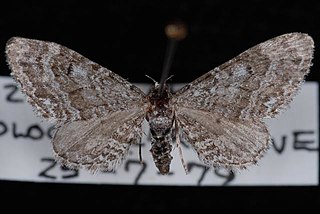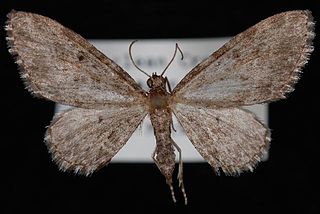
Eupithecia acutipennis is a moth of the family Geometridae first described by George Duryea Hulst in 1898. It is found in the US state of California.
Eupithecia insolabilis is a moth in the family Geometridae first described by George Duryea Hulst in 1900. It is found in the southern United States, including Utah, Arizona and New Mexico.
Eupithecia edna is a moth in the family Geometridae first described by George Duryea Hulst in 1896. It is found in the southernwestern United States, including Arizona, California, Colorado, Nevada and New Mexico.

Eupithecia borealis is a moth in the family Geometridae first described by George Duryea Hulst in 1898. It is found in North America, including Alberta, Arizona, British Columbia, California, Colorado, Manitoba, Michigan, Montana, New Brunswick, New Mexico, New York, Newfoundland and Labrador, Nova Scotia, Ontario, Quebec, Utah and Wyoming.
Eupithecia sierrae is a moth in the family Geometridae first described by George Duryea Hulst in 1896. It is found in North America, including Colorado, Wyoming, southern Utah, New Mexico, Arizona and California.

Eupithecia nimbicolor is a moth in the family Geometridae first described by George Duryea Hulst in 1896. It is found in North America from eastern Newfoundland and Labrador to western British Columbia and from Alaska to Arizona.
Eupithecia nimbosa is a moth in the family Geometridae first described by George Duryea Hulst in 1896. It is widespread in the Rocky Mountains, from Arizona to the Canada–US border.

Eupithecia multistrigata is a moth in the family Geometridae first described by George Duryea Hulst in 1896. It is widespread in western North America, including the states and provinces of Alberta, Arizona, California, Colorado, Idaho, Montana, Nevada, New Mexico, Oregon, Saskatchewan, Utah, Washington and Wyoming.

Eupithecia perfusca is a moth in the family Geometridae first described by George Duryea Hulst in 1898. It is found in western North America.

Eupithecia lachrymosa is a moth in the family Geometridae first described by George Duryea Hulst in 1900. It is found in North America from central Saskatchewan west to southern Vancouver Island, north to British Columbia and Alberta and south to California.
Eupithecia subcolorata is a moth in the family Geometridae first described by George Duryea Hulst in 1898. It is found in western North America, from British Columbia south to Arizona and New Mexico.

Eupithecia stellata is a moth in the family Geometridae first described by George Duryea Hulst in 1896. It is found in North America from central Manitoba to northern Alberta and south to California and Mexico.

Eupithecia niveifascia is a moth in the family Geometridae first described by George Duryea Hulst in 1898. It is found in North America from south-western Alberta west to Vancouver Island, north to northern coastal British Columbia and south to New Mexico.
Eupithecia flavigutta is a moth in the family Geometridae first described by George Duryea Hulst in 1896. It is found in the United States in Colorado and montane forest areas in eastern Arizona and south-western New Mexico.

Eupithecia misturata is a moth in the family Geometridae first described by George Duryea Hulst in 1896. It is widely distributed in western North America.
Eupithecia bivittata is a moth in the family Geometridae first described by George Duryea Hulst in 1896. It is found in coastal central California, United States.
Eupithecia cretata is a moth in the family Geometridae first described by George Duryea Hulst in 1896. It is found in the US state of Colorado.
Eupithecia tenuata is a moth in the family Geometridae first described by George Duryea Hulst in 1880. It is found in western North America from southern British Columbia through the Rocky Mountain region to Arizona and New Mexico.
Eupithecia implorata is a moth in the family Geometridae first described by George Duryea Hulst in 1896. It is found in the US states of California and Arizona.
Eupithecia cestata is a moth in the family Geometridae first described by George Duryea Hulst in 1896. It is found in the US state of California.








